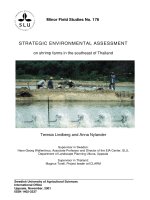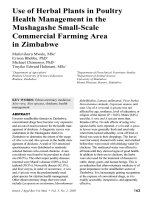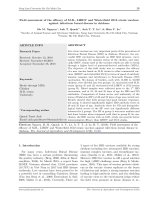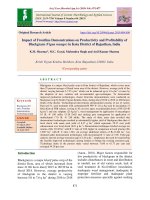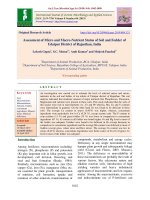Assessment of nematodes management in wheat in Hanumangarh district of Rajasthan, India
Bạn đang xem bản rút gọn của tài liệu. Xem và tải ngay bản đầy đủ của tài liệu tại đây (150.81 KB, 4 trang )
Int.J.Curr.Microbiol.App.Sci (2018) 7(11): 2389-2392
International Journal of Current Microbiology and Applied Sciences
ISSN: 2319-7706 Volume 7 Number 11 (2018)
Journal homepage:
Original Research Article
/>
Assessment of Nematodes Management in Wheat in
Hanumangarh District of Rajasthan, India
Akshaya Ghintala*, Bheiru Singh, Mukesh Kumar Verma,
Anjali Sharma and Manohar Lal Sain
Krishi Vigyan Kendra, Nohar, Hanumangarh-II (Raj.), India
*Corresponding author
ABSTRACT
Keywords
On farm trial,
Assessment, Nematodes,
Management, Wheat
Article Info
Accepted:
18 October 2018
Available Online:
10 November 2018
The finding of the study revealed that the assessed technology of T2Pacciliomyces 10 kg/ha reduced the percentage of nematodes incidence and
yield was increased recorded highest average yield (43.37 q/ha) as
compared to recommended practice and farmers practice. The results of
economic analysis revealed that on farm trials (OFTs) recorded highest
average net return of Rs. 43,330 Rs. /ha with highest average benefit cost
ratio (3.52) as compared to the recommended practice & farmers practice
(Control).
Introduction
Wheat (Triticum aestivam L.) is the world’s
most widely cultivated food crop. It is eaten in
various forms by more than one thousand
million human beings in the world (Iftikhar et
al., 2002). Besides staple food for human
beings, wheat straw also serves as good source
of feed for animals (Sarwar et al., 2006). India
is the second largest producer of wheat next to
China and achieved all time high production
of 93.9 million tonnes during 2011-12 from
29.90 million hectare area (Paroda et al.,
2012).
Nematodes occur worldwide in nearly all
environments and result in losses of
approximately 10% of world crop production
(Whitehead, 1998). About 90 species of plant
parasitic nematodes have been reported to be
associated with wheat crop. Those of
economic importance include: cereal cyst
nematode, root lesion nematode, root knot
nematode, seed gall nematode and stem
nematode (McDonald and Nicol, 2005). Out
of these cereal cyst nematode, Heterodera
avenae Woll. (CCN) is the most important and
the most studied plant-parasitic nematode on
wheat (Toktay et al., 2013).
Its worldwide distribution, predominance in
areas where cereals are grown and devastating
negative impact on yields make them major
pests affecting the world’s food supply (Cook
and Noel, 2002). It can cause about 40-50 per
2389
Int.J.Curr.Microbiol.App.Sci (2018) 7(11): 2389-2392
cent yield loss that can reach up to 60-75 per
cent in case of severe infection (Mathur et al.,
1980). In isolated areas losses in wheat up to
100 per cent have been reported in India (Van
Berkum and Seshadri, 1970). In 1960s, CCN
caused losses worth Rs. 40 million and Rs. 30
million in wheat and barley, respectively in
Rajasthan. The annual loss caused in wheat
has been estimated to the tune of Rs. 66 crores
in Haryana alone (Kanwar et al., 2007). In
Punjab, H. avenae population was adversely
affected with the cropping sequence shift from
maize-wheat and groundnut wheat to ricewheat. During 1990s under the rice-wheat
crop rotation it remained below damaging
threshold level. Since 2003, infestation of
CCN was recorded in rice-wheat rotation
fields (Kaur et al., 2009). The nematode can
be managed by cultural practices, chemicals,
using CCN resistant cultivars or by integrating
these approaches. However, resistance is
considered to be most economically effective
method of managing CCN.
Keeping above facts in view, the present
investigation was taken to study the
“Assessment of Nematodes Management in
Wheat in Hanumangarh District of Rajasthan.”
Materials and Methods
Present study was carried out by Krishi
Vigyan Kendra, Nohar, Hanumangarh-II
Rajasthan during Rabi 2013-14 to 2015-16
(three consecutive years) at farmer’s field
under on farm trials (OFTs) of different
villages for nematodes problem diagnosis low
productivity in wheat. There were 2 treatments
i.e. T0- farmers practice (Control), T1 –
Recommended practice (i.e. Carbofuran (3G)
1.5 kg/ha), T2 – Farmers & Scientist
perspective (i.e. Pacciliomyces 10 kg/ha). The
On Farm Trials were conducted by Krishi
Vigyan Kendra from Rabi 2013-14 to 2015-16
on 18 locations (farmers). Thus, a total of 18
trials were selected. All the participating
farmers were trained on various aspects of
wheat production technologies. Recommended
practices of wheat were used for on farm trials
in 0.25 hectare area per treatment. A one fifth
area was also devoted to grow local standard
check. The data collected from the reports of
trials conducted by the Krishi Vigyan Kendra
on the production technology of wheat crop
were used.
Survey was conducted in operational area at
farmer’s field to know: the socio-economic
status of farmer, farming situation, cropping
pattern and location. The existing level of
adoption of technologies on farm trials (OFTs)
site and farmers were selected to suit the
activity. Accessibility was also taken at
priority. Critical input for on farm trials
(OFTs) were also identified and made
available to farmers. These were compared
with prevailing production technologies of
wheat crop (which were taken in
recommended practice & check plots). The
performances of trials evaluated closely by the
organizing seasonal training, method of on
farm trials (OFTs), field days and by taking
crop-cut experiments. Regular diagnostic visit
by the scientists helped in proper execution of
on farm trials (OFTs) as well as collection of
farmer’s opinion about the trials field &
Recommended practice. Production and
economic data for on farm trials (OFTs),
recommended practice and farmers practice
were collected and analyzed. The experiment
comprised of the following treatments (Table
1).
Results and Discussion
Performance of On Farm Trials (OFTs)
The finding of the study revealed that the
assessed technology of T2–Pacciliomyces 10
kg/ha reduced the percentage of nematodes
incidence and yield was increased (Table 2).
2390
Int.J.Curr.Microbiol.App.Sci (2018) 7(11): 2389-2392
Table.1 Treatments used in the present experiment
Treatments
T0
T1
T2
Material (s) used
Farmers practice
Recommended practice (i.e. Carbofuran (3G) 1.5 kg/ha)
Farmers & Scientist perspective (i.e. Pacciliomyces 10 kg/ha)
Table.2 Performance of trials on Management of Nematodes in Wheat
S.N.
T0
T1
T2
Treatment
Farmers practice
Recommended practice (i.e. Carbofuran (3G) 1.5 kg/ha)
Farmers & Scientist perspective (i.e. Pacciliomyces 10 kg/ha)
2013-14
38.00
41.50
42.05
Grain Yield (qtl/ha)
2014-15
2015-16
38.00
38.75
42.50
41.50
44.25
43.80
Table.3 Economic analysis of trials on Management of Nematodes in Wheat
Net return (Profit) in Rs. / Unit
2013-14
2014-15 2015-16 Average
35,200
36,250
38,950
36,800
41,250
39,850
43,113
41,404
43,720
43,450
42,820
43,330
Result showed (Table 2) that the assessed
technology of T2-Pacciliomyces 10 kg/ha
highest average yield was recorded (43.37
q/ha) as compared to recommended practice
(41.83 q/ha) and farmers practice (38.25
q/ha).
Economic analysis of OFTs (On Farm
Trials)
The economics of wheat production under
trials were estimated and the results of the
study have been presented in Table 3. The
results of economic analysis of wheat
production revealed that on farm trials (OFTs)
recorded highest net return was recorded
during 2013-14 (Table 3). T2: Pacciliomyces
10 kg/ha a highest average net returns of Rs.
43,330 per ha with highest average benefit
cost ratio (3.52) as compared to T1:
Recommended practice (i.e. Carbofuran (3G)
1.5 kg/ha) average net returns of Rs. 41,404
2013-14
3.73
3.88
3.89
B:C ratio
2014-15 2015-16
2.96
3.01
3.26
3.18
3.35
3.31
Average
3.23
3.44
3.52
per ha with average benefit cost ratio (3.44)
and farmers practice average net returns of
Rs. 36,800 per ha with average benefit cost
ratio (3.23).
The finding of the study revealed that the
assessed technology of T2-Pacciliomyces 10
kg/ha highest average yield was recorded
(43.37 q/ha) as compared to recommended
practice (41.83 q/ha) and farmers practice
(38.25 q/ha). The results of economic analysis
of wheat production revealed that on farm
trials (OFTs) recorded highest net return was
recorded during 2013-14. T2: Pacciliomyces
10 kg/ha a highest average net returns of Rs.
43,330 per ha with highest average benefit
cost ratio (3.52) as compared to T1:
Recommended practice (i.e. Carbofuran (3G)
1.5 kg/ha) average net returns of Rs. 41,404
per ha with average benefit cost ratio (3.44)
and farmers practice average net returns of
Rs. 36,800 per ha with average benefit cost
2391
Average
38.25
41.83
43.37
Int.J.Curr.Microbiol.App.Sci (2018) 7(11): 2389-2392
ratio (3.23). The Trials also built the
relationship and confidence between farmers
and scientist of Krishi Vigyan Kendra.
Therefore it is suggested that these factors
may be taken for considered to increase the
scientific temperament of the farmers.
References
Anonymous, (2013-14 to 2015-16). Annual
Progress Report, Krishi Vigyan Kendra,
Nohar, Hanumangarh-II.
Cook R and GR Noel. (2002). Cyst
Nematodes: Globodera and Heterodera
Species. In: Starr JL, Cook R and
Bridge J (eds.) Plant Resistance to
Parasitic Nematodes. Journal of Wheat
Research.
CAB
International,
Wallingford, UK. Pp 71-105.
Iftikhar, M. H., Shamshad, H. S., Hussain, S.
and Iqbal, K. (2002). “Growth, yield
and quality response of three wheat
(Triticum aestivum L.) varieties to
different levels of N, P and K”.
International journal of Agricultural
biology. 4: 362-364.
Kanwar RS, SN Nandal, IJ Paruthi and HK
Bajaj. (2007). National Symposium on
Nematology in 21st century: Emerging
paradigms. Proc. 7th NSN, AAU, Jorhat.
Pp 40.
Kaur DJ, I Sharma, VS Sohu, NS Bains and Y
Singh. (2009). Status of cereal cyst
nematode in wheat cropping systems
and resistance in Punjab, India. In:
Riley IT, JM Nicol (eds.) Cereal cyst
nematode: status and research.
CIMMYT, Ankara, Turkey. Pp 88-93.
Mathur BN, DK Handa, S Swaroop, CL Sethi,
GL Sharma and BD Yadav (1980). On
the loss estimation and chemical control
of molya disease of wheat caused by
Heterodera avenae in India. Indian
Journal of Nematology 16: 152-159.
McDonald AH and JM Nicol (2005).
Nematode parasites of cereals. In: Luc
M, Sikora RA and Bridge J (eds.) Plant
parasitic nematodes in subtropical and
tropical agriculture. CAB International,
Wallingford, UK. Pp 131-91.
Paroda R, S Dasgupta, B Lal, SS Singh, ML
Jat and S Gajendra (2012). Proceedings
of the regional consultation on
improving wheat productivity in Asia.
Bangkok, Thailand. Pp 48.
Sarwar, N., Maqsood, M., Mubeen, K.,
Shehzad, M., Bhullar, M. S., Qamar, R.,
and Akbar, N. (2006). “Effect of
different levels of irrigation on yield
and yield components of wheat
cultivars”.
Pakistan
Journal
of
Agricultural Science. 47: 371-734.
Toktay H, M Yavuzaslanoglu, JM Nicol, IH
Elekçio lu and A Dababat (2012).
Screening for resistance to Heterodera
filipjevi and Pratylenchus thornei in
sister lines of spring wheat. Journal of
Turkish Entomology 36(4):455-461.
Van Berkum JA and AR Seshadri (1970).
Some important nematode problems in
India. Proc. 10th Int. Nema. Symp.
Pescara, Italy. pp 136-137.
Whitehead AG. (1998). Plant nematode
control.
CAB
International,
Wallingford, UK. Pp. 384.
How to cite this article:
Akshaya Ghintala, Bheiru Singh, Mukesh Kumar Verma, Anjali Sharma and Manohar Lal
Sain. 2018. Assessment of Nematodes Management in Wheat in Hanumangarh District of
Rajasthan, India. Int.J.Curr.Microbiol.App.Sci. 7(11): 2389-2392.
doi: />
2392
